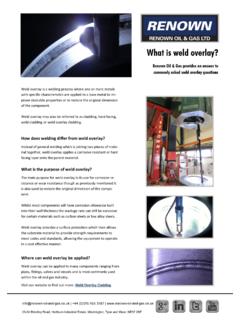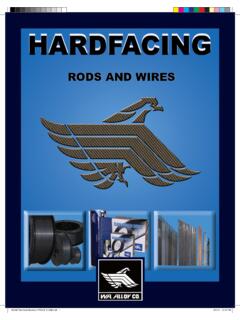Transcription of Electro Slag Strip Cladding Process - IJMER
1 International OPEN ACCESS Journal Of Modern Engineering Research ( IJMER ) | IJMER | ISSN: 2249 6645 | | Vol. 4 | | July. 2014 | 60| Electro Slag Strip Cladding Process Thakare Niraj S1, Ram Yadav2 1, 2 Mechanical Engineering/ SSJCET College, India I. INTRODUCTION The Welding is a material joining Process used in making welds, and a weld is localized coalescence of metals or non-metals produced either by heating the material to a suitable temperature with or without the application of pressure and with or without the use of filler metal.
2 Welding is a fabrication or sculptural Process that joins materials, usually metals or thermoplastics, by causing coalescence. This is often done by melting the workpieces and adding a filler material to form a pool of molten material (the weld pool) that cools to become a strong joint, with pressure sometimes used in conjunction with heat, or by itself, to produce the weld. This is in contrast with soldering and brazing, which involve melting a lower-melting-point material between the workpieces to form a bond between them, without melting the workpieces. Many different energy sources can be used for welding, including a gas flame, an electric arc, a laser, an electron beam, friction, and ultrasound.
3 While often an industrial Process , welding may be performed in many different environments, including open air, under water and in outer space. Welding is a potentially hazardous undertaking and precautions are required to avoid burns, electric shock, vision damage, inhalation of poisonous gases and fumes, and exposure to intense ultraviolet radiation. Until the end of the 19th century, the only welding Process was forge welding, which blacksmiths had used for centuries to join iron and steel by heating and hammering. Arc welding and oxyfuel welding were among the first processes to develop late in the century, and electric resistance welding followed soon after.
4 Welding technology advanced quickly during the early 20th century as World War I and World War II drove the demand for reliable and inexpensive joining methods. Following the wars, several modern welding techniques were developed, including manual methods like shielded metal arc welding, now one of the most popular welding methods, as well as semi-automatic and automatic processes such as gas metal arc welding ,submerged arc welding, flux-cored arc welding and electroslag welding. Electro slag Strip Cladding is an advancement of submerged arc Strip Cladding , which has speedily established itself as a reliable high deposition rate procedure.
5 ESW is an arc less technique using Joules Effect to liquefy the Strip material. The heating is an outcome of current flowing through the Strip electrode and a relatively shallow layer of liquid Electro conductive slag as shown in figure 1. The penetration is lesser for ESW than for SAW since the molten slag pool is used to liquefy the Strip and some of the flux material rather than as an arc between the Strip electrode and the flux material. As a rule of thumb, Electro slag Strip surfacing decreases dilution by up to 50% in contrast with submerged arc Strip surfacing for the same heat input with a significantly higher deposition rate.
6 Abstract: The Technological advancements have driven up temperature and pressure serviced in the petroleum, chemical, pulp, and environmental protection. Industries have increased the possibility of severe corrosion and wear in Process pressure vessels. The industries must upgrade the corrosion and wear performance of these main important parts .Economic features as a rule will not allow fabricating components from solid high alloyed materials. As a result it is essential to surface non-alloyed or low alloy base materials with high-alloy Cladding . The submerged arc welding(SAW) and electroslag welding (ESW) Process are appropriate for applying welded deposits over large surface areas by means of Strip electrodes.
7 Both processes are using a granular flux material. A Strip electrode, fed continuously, is liquefied and fused to the substrate. In contrast with other processes it is very effective in spite of the same equipments used but due to the wide Strip used it procures a magnetic flow effect within to rectify it a magnetic steering device is exercised. After the welding to examine the defects NDT's are carried upon it. Keywords: Cladding , Electro slag welding, weld overlay. Electro Slag Strip Cladding Process | IJMER | ISSN: 2249 6645 | | Vol.
8 4 | | July. 2014 | 61| II. METHODOLOGY Cladding Cladding is the bonding together of dissimilar metals. In many cases, corrosion resistance is required only on the surface of the material and carbon or alloy steel can be clad with a more corrosion resistant alloy. Compared to carbon and alloy steels, all corrosion resistant alloys are expensive. Cladding can save up to 80% of the cost of using solid alloy. Cladding of carbon or low alloy steel can be accomplished in several ways including roll bonding, explosive bonding, weld overlaying and wallpapering. Clad materials are widely used in the chemical Process , offshore oil production, oil refining and electric power generation industries.
9 The use of clad steel is not new. Corrosion resistant alloy clad steel has been available for over 40 years. Almost any corrosion resistant stainless steel or nickel alloy can be bonded to steel. The steel can be clad on both sides or on one side only. Hence Strip Cladding is a fusion welding technique used to: Deposit a Strip of weld metal on to a component to achieve the desired dimensions or properties. Weld two dissimilar surfaces. Providing a wear or corrosion resistant surface. Weld overlaying technique of Cladding is commonly used to clad the surfaces of fabricated steel structures.
10 The actual weld overlay Process used depends on many factors including access, welding position, the alloy applied, and economics. In some alloy combinations, dilution of the weld overlay material by the steel requires that more than one weld pass is required. Post weld heat treating to temper the backing steel may be required in some cases. Strip Cladding can be a very economical way to provide excellent corrosion resistance for steel structures. Both stainless steels and the more corrosion resistant nickel alloys can be economically applied to steel by Strip Cladding .





